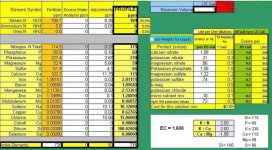Thanks for the update spurr. That was my assumption for your feeding schedule. I just thought it would be good include that with the nute mixes on this page. Over fertilizing was never an issue for me but I met many newer growers who see a formula and assume they use that with every watering.
I use 50/50 RO water as well and have a similar alkalinity of my tap water. Before 50/50 RO I was filtering through peat to remove chlorine and chloramine. I was just debating with myself whether or not I should be doing something like adding Ascorbic Acid to remove those from the tap half of my water mix. Based on what you wrote I am assuming you feel they should be left alone for a source of chlorine despite the addition of chloramine as well.
That is my current line of thinking, but I'm not sure it's the best route. I need to look into whether plant can using chloramines in place of chlorine, and/or conversion of chloramines into chlorine (or other forms) by root exudates and/or microbial exudates.
My plants do not 'look' better when I remove all chloramines via ascorbic acid vs not removing chloramines from the 50% tap water ... ex., citric acid can 'remove' Cl via chemistry based process, and I think citric acid can do something similar to choloramines; and citric acid is a very common root exudate and often found as exudates from some type of microbes.
If I were growing organically I would remove the chloramines from tap water because they can hinder the microbes I would be trying to cultivate. That said, Cl can be found upwards of 10 ppm in top soils closer to oceans; Cl is ubiquitous in nature, often as NaCl. Plants use Cl, mostly within chloroplasts, it is helpful to them.
Also really glad to hear about how well the IceBoxes are working. Looking forward to your grow logs that show pictures that setup. There really haven't been many threads that go into detail about icebox setups and success rates using them.
Yea, I agree, I have yet to see a single thread where IceBoxes were used to cool the heat from lamps and to cool the room. And in my case, it's done with a lower cost water chiller (~$1,000) and lower cost water pumps (both EcoPlus, for the IceBoxes I use one ECO-2245 GPH and for the chiller I use one ECO-1056 GPH). And I use an el-chepo' 32 gallon trash can from HomeDepot for my rez with 30 gallon of tap water I change every 2 weeks (so it has chloramines to help kill microbes so they don't easily populate my rez).
To make the pumps useable (i.e., so I could attach the 0.5" I.D. hose) I had to use a step-down rubber adapter made for use with washer machines; to enable use of the larger than 0.5" male connecter provided by the pump manufacture. I also had to use an ad-hock method to attach the 0.5" I.D. hoses to the water chiller, too. But I will write about that and take pics, etc., for my grow logs soon; maybe today.
FWIW, here are some links to products so you can see what I use:
EcoPlus 1 HP commercial grade water chiller (the white version, *DO NOT* get the black one; ~$1,000 plus a hundred or more in LTL shipping depending upon where you live)
EcoPlus water pump model "ECO-1056" (for the water chiller, this is a correct sized pump; bigger can damage the chiller; ~$55)
EcoPlus water pump model "ECO-2245" (for the IceBox(es), it has max head lift of 16.5 feet so it should work for most situations, but there are better pumps than this one; ~$110)
IceBox thermostat (separate day/night temp pre-sets, so the fan will speed up or slow down depending upon air temp, but the fan never stops, even at night; ~$110)
EcoPlus water pump model "ECO-1056" (for the water chiller, this is a correct sized pump; bigger can damage the chiller; ~$55)
EcoPlus water pump model "ECO-2245" (for the IceBox(es), it has max head lift of 16.5 feet so it should work for most situations, but there are better pumps than this one; ~$110)
IceBox thermostat (separate day/night temp pre-sets, so the fan will speed up or slow down depending upon air temp, but the fan never stops, even at night; ~$110)






